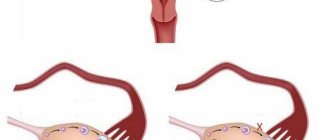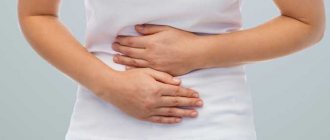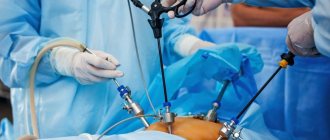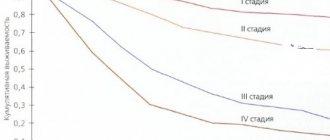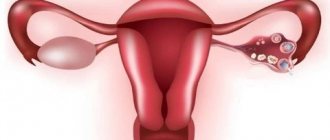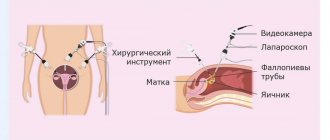Stein-Leventhal syndrome occurs in every fifth woman during the fertile period.
Pronounced signs of polycystic disease are most often absent, and problems with conception are often the reason for visiting a doctor. Despite the fact that polycystic ovary syndrome causes a lot of trouble, it is not a death sentence, you just need to take care of your health in time and undergo a course of treatment. With PCOS, there is an increase in luteinizing hormone (LH) and male sex hormones in the blood. The reasons are not well understood; there is a high probability of a hereditary factor in the development of the pathology. Many women, upon learning of their diagnosis, remember that their mother or other relatives also had problems conceiving. The main symptom of PCOS (Stein-Leventhal syndrome) is enlarged, due to the formation of numerous cysts, the so-called polycystic ovaries. They are usually detected during an ultrasound.
Women who are diagnosed with polycystic ovaries are interested in: “How to get pregnant? What treatment is required?”, because due to cystic changes, the normal functioning of the ovary, blood supply and supply of nutrients are disrupted. PCOS is characterized by the fact that the egg matures, but ovulation does not occur. The level of estrogen in the blood increases and the amount of progesterone decreases. This disrupts the normal development of the endometrium of the uterus. It actively grows under the influence of estrogens and thickens. This can cause a delay in menstruation and menstrual irregularities. And menstruation itself becomes profuse, and uterine bleeding may develop.
Signs and symptoms
During the menstrual cycle in the reproductive period, folliculogenesis occurs - the maturation of follicles containing eggs. The follicles grow, and before ovulation, one of them ruptures, releasing an egg (ovulation), which, under favorable conditions, can be fertilized. Other follicles undergo the opposite change. This happens normally. If an ultrasound examination reveals more than 10 small underdeveloped follicles in any phase of the cycle, a diagnosis of polycystic ovary syndrome (PCOS) is made. Follicles that have not completed their physiological development are located along the periphery of the ovary, the center is not thickened. There are no cysts themselves in the classical sense on the ovaries.
Polycystic ovary syndrome manifests itself individually, and there is no clear clinical picture for all patients with this disease. Most often there is a combination of symptoms in different variations. Some women may not even have echo signs of the disease (on ultrasound), but the combination of hyperandrogenism with the absence of ovulation gives reason to suspect PCOS. Sometimes polycystic ovary syndrome can occur with ovulation, but echo signs of PCOS and hyperandrogenism must be present to make a diagnosis.
Due to the absence of specific characteristic symptoms, it is impossible to feel that PCOS has developed, but a woman should be alerted to the appearance of the following signs:
- Instability of the menstrual cycle, irregularity, pain, heavy discharge or, conversely, its complete cessation, non-cyclical discharge.
- Increased hair growth in areas unusual for women (face, chest, abdomen).
- Fat deposits on the abdomen and waist.
- Alopecia (hair loss on the scalp).
- Increased oiliness of hair, skin, acne.
These endocrine disorders may indirectly indicate the presence of polycystic ovary syndrome. But to clarify the diagnosis, an examination by a specialist and additional instrumental studies are required.
Hyperandrogenism occurs as a result of intense production of male hormones (testosterone, androstenedione) in the female body. The cause may be genetic predisposition, dysfunction of the pituitary gland and hypothalamus, pituitary tumors. Previously, hyperandrogenism was considered an obligatory and defining sign of PCOS; now the diagnosis is made even with normal levels of male hormones. The situation is similar with obesity. Excess male hormones lead to fat deposition mainly on the waist and abdomen. But today PCOS is also registered in women with normal weight. Although excess body weight is the most important factor in the development of the disease.
This is due to the fact that adipose tissue is capable of producing estrogens, which causes hormonal imbalance. Their excess has an adverse effect on the entire body and hormone-producing cells. The secretion of many hormones is regulated by feedback; in addition, their active effect on the body, transport in the blood, is carried out by binding to proteins of the same type. Therefore, changes in the blood levels of one hormone also affect others.
How can you tell if a woman has PCOS? Are there any external signs of illness?
The clinical picture of polycystic disease may be characterized by the following manifestations:
- menstruation disorders, the cycle may be too long or, conversely, short; discharge is abundant or scanty compared to usual; the interval between menstruation can become so long that amenorrhea occurs;
- hair growth is observed on the body in the back, abdomen, chest and chin;
- body weight is increased (if you measure the index, it will be more than 30);
- Stretch marks and stretch marks become noticeable on the hips;
- hair falls out more than usual, nails become brittle;
- Acne appears clearly on the skin.
Complications of Stein-Leventhal syndrome
PCOS can cause serious complications:
- Menstrual disorder.
- Miscarriage.
- Infertility.
- Oncological diseases of the genital organs.
- Cardiovascular disorders.
- Diabetes mellitus type 2.
Patients with polycystic disease should be informed about this possibility and undergo preventive examinations more often, since they are at risk. With PCOS, the body's sensitivity to insulin (a hormonal substance produced by the pancreas that regulates glucose levels in the bloodstream) decreases. This condition, called insulin resistance, leads to a significant increase in insulin levels in the blood. In turn, high levels of insulin promote excess synthesis of androgens, which lead to changes in the ovaries, reducing their function and changing their structure.
Male hormones interfere with the normal growth of eggs and cause thickening of their outer shell, as a result of which a mature egg is not able to break through the thickened wall of the follicle in order to come out for fertilization. The remaining unruptured follicles become cysts, filling with fluid. Therefore, the ovaries increase in size. Removal, making cuts on the thickened membrane to facilitate the release of the egg, is the basis of surgical treatment for PCOS.
Diagnostics
Despite the fact that women more often turn to a gynecologist about infertility, upon examination they may notice some symptoms that may suggest polycystic ovary syndrome. In the anamnesis, they note irregularity of the menstrual cycle, scanty or heavy menstruation. Upon examination, a woman with PCOS may be diagnosed with hirsutism, excess male-pattern hair growth. Increased weight and acne that cannot be treated are also signs of hormonal imbalance.
PCOS (Stein-Leventhal syndrome) is diagnosed using the following methods:
- Blood test for hormones.
- Ultrasonography.
- An endometrial biopsy is performed using diagnostic laparoscopy - a biopsy sample is taken for morphological examination. Indications include bleeding outside the menstrual cycle.
- Laboratory blood test.
- Glucose tolerance test.
- Sonography (ultrasound examination) of the pelvic organs is performed transvaginally. In PCOS, the study shows the presence of multiple modified follicles (size up to 10 mm), localized on the periphery, a significant increase in ovarian volume (more than 9 cubic cm), thickened stroma, which makes up a quarter of a percent of the total volume of the ovaries.
Specialist consultation
If you are faced with a problem such as polycystic ovary syndrome, then the treatment of this pathology must be left to an experienced specialist with a wide profile of work. Romanov Georgy Nikitich is an endocrinologist and candidate of medical sciences, his work experience is almost 25 years. He studied in many clinics in the CIS, and also did internships in several Western countries.
Romanov Georgy Nikitich knows modern methods of treating many diseases that are caused by hormonal system disorders. Today, this specialist has the opportunity to help patients from different parts of the country, as well as citizens of other countries - he conducts paid online consultations, remotely studies the results of diagnostic procedures, prescribes and monitors the treatment of his patients. You can contact a specialist in a messenger or social network convenient for you.
How is Stein-Leventhal syndrome treated?
Despite the fact that the exact causes of PCOS are unknown, modern medicine has developed methods for correcting hormonal levels and treating infertility. One of the important factors in restoring hormonal levels is the fight against excess weight. Changes in the sensitivity of insulin receptors cause increased formation of adipose tissue and weight gain. And adipose tissue is capable of synthesizing estrogens, the increased level of which, through feedback, reduces the production of follicle-stimulating hormone (FSH). Therefore, the fight against excess weight plays an important role in the treatment of polycystic ovary syndrome complicated by infertility. After all, FSH stimulates the growth of follicles and the full maturation of the egg.
If you are diagnosed with polycystic ovary syndrome, in addition to drug treatment, it is recommended to play sports or exercise, and walk in the fresh air more often. Physical activity increases muscle sensitivity to insulin. You also need to eat right. If all this does not help, you may have to resort to liposuction.
In many cases of PCOS, a reduction diet is prescribed during treatment, which helps not only to cope with excess weight, but also to normalize lipid and carbohydrate metabolism. The diet consists of reducing daily caloric intake. Of the required 2000 kilocalories, carbohydrates make up 52%, fats - 32% (of which a third are unsaturated fats), proteins - 16%. The intake of hot, spicy, salty foods, marinades, and liquids is limited. Fasting days are observed. You should not starve, this negatively affects glucogenesis.
Often, with PCOS, treatment for which is selected strictly individually, patients are prescribed oral contraceptives, this helps to temporarily normalize cycle disorders and reduce the severity of symptoms, but they can be used up to 35 years of age, in addition, they are not recommended if the woman smokes.
conclusions
Steil-Leventhal syndrome cannot be completely cured today, since the main reason for its occurrence is unknown. Medicine knows the mechanism of the disease, and treatment is carried out with the aim of normalizing these mechanisms.
To prevent pathology, you need to visit a gynecologist, monitor the condition of the thyroid gland, your weight, conduct routine ultrasound diagnostics of the pelvic organs, have regular physical activity, a stable emotional background and eat right.
Pregnancy and polycystic disease
You can get pregnant with polycystic disease without treatment, you just have less chance of getting pregnant. Moreover, every year the number of cysts increases, this adversely affects the ovarian tissue, so treatment in order to become pregnant must be carried out as early as possible, since with age the likelihood of conceiving a child becomes even less.
Treatment consists of hormonal correction and ovarian stimulation. If a woman experiences menstrual irregularities, she is prescribed oral contraceptives to normalize it. After their use, periods begin regularly and conception is possible. If pregnancy still does not occur, you can try ovarian stimulation. It is carried out according to various schemes, only under the supervision of a doctor. You cannot take ovulation-stimulating drugs on your own, as this can lead to hyperstimulation, which is dangerous for a woman’s health.
If ovarian stimulation does not help, laparoscopic surgery is possible, during which the cysts are dissected and the dense lining of the ovary is removed, which helps restore blood circulation and normal functioning. Of course, this is a temporary measure, since the cystic changes will form again, but while this happens, the woman’s chances of becoming pregnant increase.
Polycystic ovary syndrome can be eliminated using the following surgical techniques:
- Wedge resection is the excision of androgen-producing ovarian tissue.
- Electrocautery is a low-traumatic procedure that involves destroying tissues that excessively synthesize androgens.
Such operations are now performed using an endoscopic technique - laparoscopy. This is a low-traumatic method of surgical intervention, which is used for both diagnosis and treatment. If polycystic disease is suspected, diagnostic laparoscopy is prescribed. If during the inspection of the abdominal cavity specific changes are detected in the ovaries, the membrane and cystic formations are dissected. The advantages of laparoscopy are that it reduces the risk of formation of adhesions in the abdominal cavity and shortens the rehabilitation period. Often, PCOS is accompanied by adhesions and obstruction of the fallopian tubes. These pathological conditions can be eliminated during laparoscopy.
After a successful operation, ovulation is restored after six months to a year, then the reproductive organs are ready for conception. If pregnancy does not occur after this time, then additional drug therapy is performed. If there is no effect in this case, the best way to get pregnant is to resort to IVF (Read more about in vitro fertilization in this material - note altravita-ivf.ru).
It should be taken into account that when a long-awaited pregnancy occurs after treatment and stimulation, a relapse of polycystic ovary syndrome is possible over a five-year period. Therefore, it is advisable to prevent PCOS after pregnancy, which consists of taking hormonal drugs.
What to do if after 3-6 months of treatment there is no ovulation?
If hormonal therapy does not have the desired effect, surgical intervention is required, in particular laparoscopy:
- decortication of the ovaries - the follicles are pierced with a needle;
- endothermocoagulation – targeted cauterization of the ovaries.
After laparoscopy, 50% of patients require ovulation induction. If there is no ovulation within 12 weeks, clomiphene citrate is prescribed. Another 6 months have passed and there is no result? The use of gonadotropins is recommended.
